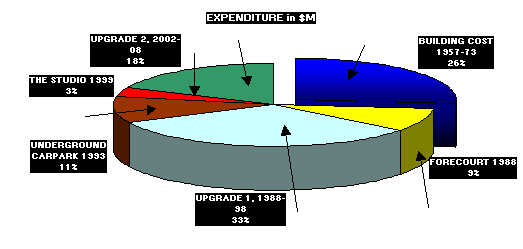SYDNEY
OPERA HOUSE
Site,
Design, Construction, Costs
Notes
for presentation to TAFE Students, Sydney, 2002
By
Philip Drew
________________________________________________________________
Much as the Eiffel Tower defined Paris, Sydney
is recognised around the globe by its Opera House. This presentation traces the chief moments in its creation
and use to the present day, from the choice of site to the original
requirements, JÝrn Utzonís unique concepts, the search for a roof solution,
and costs. The building cost represents only 26% of the expenditure since
1973.
Selecting
a site
Requirements
1956
Utzon's
concepts
The
roof design 1957-1962
The
roof construction
Estimates
and expenditure 1957-1973
Changes
& expenditure 1973-2002
Total
expenditure
Everyone
agrees that the choice of Bennelong Point for the new Sydney Opera House in
1955 was brilliant, however, few people are aware how many alternatives were
considered initially before Bennelong Point was selected. 21
sites were investigated, including:
-
Macquarie
St (Domain and Sydney Hospital)
-
Philip
Park (including Haig Ave)
-
Vicinity
of Conservatorium
-
Fort
Macquarie (Bennelong Point)
-
Domain
(near Art Gallery of NSW)
-
Prince
Alfred Park
-
City
Markets
-
Corner
College Street-Liverpool streets (City Council proposal)
The
original requirements set out in the competition were for two multi-use halls.
In the process of its realisation, after Utzonís departure in 1966,
these requirements were lost sight of and Grand Opera was abandoned in the
Major Hall, with opera relegated to the Small Hall, which was intended as a
theatre.
The
1956 Competition brief asked for:
-
Large
Hall seating 3,000-3,500 persons for symphony concerts, large-scale pera,
ballet and dance, choral, pageants and mass meetings
-
Small
Hall to seat approximately 1,200 persons for dramatic presentations,
intimate opera, chamber music, concerts and recitals, lectures
-
Restaurant
to seat 250 with lounge, bar, etc, 2 meeting rooms for 100, 200 people
Compared
to the other competition schemes, JÝrn Utzonís winning scheme stood apart
because of its unique ideas inspired by such examples as Mayan temples,
Kronborg Castle, the City Hall in Stockholm and experiments with shell roofs
in Copenhagen which he witnessed as a young architecture student. His ideas,
whilst obviously drawn from a diverse range of sources, carried a the imprint
of his unique genius.
Utzon
included a number of unique ideas:
-
Opera
House as a civic focus to connect Sydney with its harbour
-
Processional
way from Circular Quay to theatres
-
Overlapping
roof silhouettes
-
Contrasting
composition of platform versus roof shells-performance functions rest on
service functions
-
Shell
roof shapes moulded around interior volumes
-
Ancient
Greek theatre seating
-
Spherical
geometry applied to roof shapes
-
Nature
as inspiration: beech trees and waves in auditoria
It took
Utzon and Ove Arup and Partners some five years to solve the roof.
In their search for a solution, a variety of geometries were
investigated leading to Utzonís proposal for a spherical solution which was
ultimately adopted as the simplest and least complex geometry for determining
the roof shape.
Ove
Arup and Partners London Office considered many geometries:
Ove
Arup and Partners explored a range of constructions starting with Utzonís
suggestion for a single skin reinforced concrete shell with stiffening ribs.
Double skin and space frame solutions were seriously debated before the
present precast hollow ribbed vault was adopted.
The
engineer also investigated many types of construction before settling on the
final precast ribbed vault with insitu solution
-
Single
skin reinforced concrete with ribs
-
Single
skin shell with ribs
-
Double
skin reinforced concrete with 2-way ribs and structural louvre wall
-
Steel
space frame with reinforced concrete skin, louvre shell
replacing louvre wall
-
Insitu
and precast concrete
-
Precast
reinforced concrete ribs, structural stage tower walls
-
Precast
reinforced concrete partially insitu
Today, the cost of the building ($102 million)
seems extremely cheap. Utzonís contribution of $18.4 million to complete
Stages 1 & 2 is extraordinarily economical considering the later benefits
to Sydney and Australia of the Opera House, as venue and as a symbol.
The blue columns represent the main estimates which caused such
political anger at the time, the brown, yellow ones, real spending by Utzon,
the last pale blue column, by far the greatest expenditure, was by the
architectural team that replaced Utzon.
Expenditure on the Sydney Opera House since its
completion dwarfs the initial building cost of $98.8M which is some 26% of
what is either proposed or has been expended.
The pie chart shows the major additions and projects undertaken since
1973 and further includes the Second Upgrade by Richard Johnson costing
$66.59M which was included in the NSW governmentís June 2002 budget. By far
the single greatest investment was the First Upgrade, 1988-1998, which cost
$120M.

|
|
|
Actual
Million |
| STAGE
1: PLATFORM: 1957-1963
(Architect: JÝrn Utzon) |
$5.2
|
| STAGE
2: ROOF: To
Feb 1967 (Architect: JÝrn Utzon) |
$13.2
|
| STAGE
3: INTERIOR: To
June 1973 (Architect: Peter Hall) |
$80.4
|
| FORECOURT
REFURBISHMENT: 1988
(Andrew Andersons) |
$34.6
|
| UPGRADE
1: EXTERIOR / INTERIOR:
1988-1989
(PWD) |
$120.0
|
| UNDERGROUND
CAR PARK: To
1993 Mar 17 |
$40.0
|
| THEATREWORKS
/ THE STUDIO / CH ANTEROOM / WESTERN BROADWALK FOYER:
To
1999 Mar 5 (Architect: Leif Kristensen) |
$12.0
|
| UPGRADE
2: EXTERIOR / INTERIOR:
1998-2002
(Architects: Richard
Johnson / JÝrn & Jan Utzon) |
*$69.0
|
| TOTAL |
$374.4
|
Table: Sydney Opera House
Construction and Refurbishment Expenditure 1957-2002
*
$69 million committed